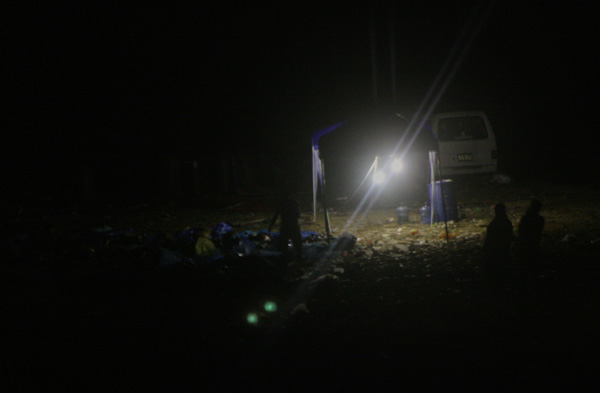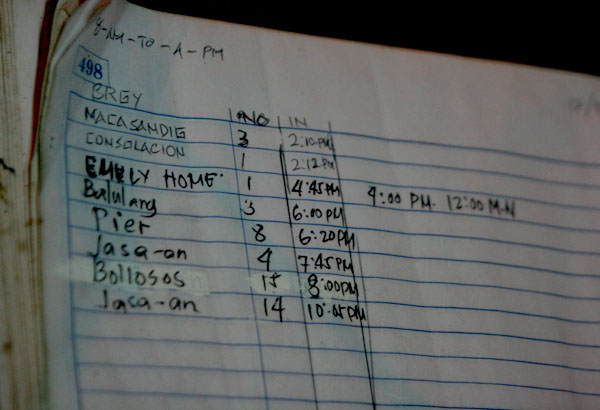CAGAYAN DE ORO CITY (MindaNews/20 December) – Looking for your mother, father, wife, husband, daughter, son, brother, sister who have been missing since Saturday’s flashfloods? Go to the city’s dumpsite. That’s where they dumped your loved ones for you to identify and claim.
At least 79 corpses – more than half of them from funeral parlors that could no longer attend to them – and 34 recovered from various parts of the city and neighboring Jasaan town in Misamis Oriental on Monday — had been dumped there since Sunday night.
 The 34 newly-retrieved cadavers were brought to the city’s landfill in Zayas, Barangay Carmen between 2:10 p.m. and 10:05 p.m.. Monday.
The 34 newly-retrieved cadavers were brought to the city’s landfill in Zayas, Barangay Carmen between 2:10 p.m. and 10:05 p.m.. Monday.
Fifteen more cadavers from the Bollozos Funeral Homes, loaded on a Barangay Assistance Center truck, were dumped at 8 p.m. Monday in addition to the 30 cadavers transferred there from the Bollozos and Somo funeral homes Sunday night.
MindaNews visited the landfill at noon and returned at 11:30 p.m. Monday to check if more bodies were dumped there.
Jonald Bacas, a Metro Aide detailed as guard in the landfill, gave MindaNews an accounting of the 34 newly-retrieved cadavers dumped there: at 2:10 p.m. three cadavers from Barangay Macasandig; at 2:13 p.m, one from Barangay Consolacion; at 4:45 p.m, one from Emily Homes; at 6 p.m. three from Barangay Balulang; at 6:20 p.m., eight from the Pantalan (wharf); at 7:45 p.m., four from Jasaan in Misamis Oriental and at 10:05 p.m., another 14 from Jasaan.
Bacas said he has no record of the number of cadavers brought to the site Sunday night because he was not on duty. But a worker manning the gate Monday noon told MindaNews there were about 30 corpses dumped there the night before.
Only five of the 79 cadavers brought there had been pulled out of the dump by their relatives on Monday.
Bacas said relatives from Baungon in Bukidnon came to retrieve a loved one from the dump but were wondering how to bring their dead home because the bridge to Baungon from Lumbia in Cagayan de Oro City had been destroyed by rampaging floodwaters at the height of typhoon Sendong’s fury.
“Ang mga bag-o wala pang mga relatives kay hindi pa man nila alam” (the new ones, there are no relatives who came because they still don’t know [that they’re here]), said Bacas.
Earlier at noon, one of the relatives who went to the dumpsite said they had actually identified their loved one at the funeral parlor but because of the huge number of corpses, the cadaver had started to decompose because of lack of embalmers. The relative wanted to know why the bodies were transferred to the dumpsite.
 Bacas had greeted MindaNews with the news that “naa na ilaw didto” (the area is lighted now), referring to the area in the landfill past the mountains of trash, where the cadavers were dumped.
Bacas had greeted MindaNews with the news that “naa na ilaw didto” (the area is lighted now), referring to the area in the landfill past the mountains of trash, where the cadavers were dumped.
MindaNews saw at noon how the cadavers were exposed to the elements, the dogs and flies and maggots and worms. In the midnight visit to the dumpsite, more dogs were seen and heard barking near the dead.
While efforts of citizens and groups to ease the pain of the survivors and those who lost their loved ones have been commendable, the city government’s act of dumping the dead, stripping them of their dignity and causing their relatives more pain, had been condemned as an “act of inhumanity,” “evil deed,” “heartless.”
MindaNews sought Mayor Vicente Emano twice to explain why the cadavers were ordered dumped at the city landfill but he was unavailable.
Figures vary but what is certain is at least 200 died and at least 200 are still missing in Cagayan de Oro.
Those who are looking for loved ones who have been missing since Saturday’s flashfloods have to walk (if they have no vehicle) the 800-meter stretch from the entrance of the landfill to where the bodies have been dumped.
But they will have to battle with nausea from the the obnoxious smell of garbage and the flies to get to the area of the decomposing corpses – from where they might find their mother, father, wife, husband, daughter, son, brother, sister. (Carolyn O. Arguillas/MindaNews)
